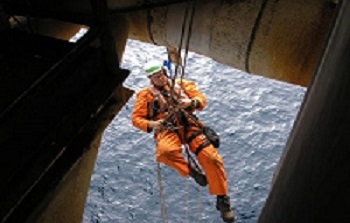Rope Access-Abseiling:
ROPE ACCESS:
ATIC provide a wide range of services using the rope access we do have NDT technicians, API inspectors, blasters, painters welders and grinders etc.
- All technicians are independently assessed.
- All equipment is regularly inspected and maintained.
- Carefully refined codes of practice and working systems are used.
- This approach has meant very few accidents since the beginning of this activity around 1980s.
- Typical Applications.
Typical applications include:
- Inspection, painting and construction on offshore oil platforms and power plants.
- Inspection, surveying, maintenance on wind turbines.
- Inspection, surveying, maintenance, and construction on bridges and dams.
- Window cleaning, repair and aircraft warning light maintenance on high-rise buildings.
- Maintenance on aerials, telecommunication and electrical transmission towers (pylons).
- Construction assist on stadiums, spires, and other unique shape structures.
- Geologic slopes.
- Inspection, documentation and access to large building.
- Rope access to a turret clock
- When working a rope access technician always has at least 2 attachments, each having an independent anchorage point.
- When the worker is supported by ropes, each of the worker's ropes will have a fail-safe descent mechanism.
- All secondary tools and equipment (e.g. drills, sealant, etc.) are attached by lanyards to the worker's harness to avoid danger to people below.
- A minimum of two trained technicians are required for any job, each with the ability to rescue the other if needed.



